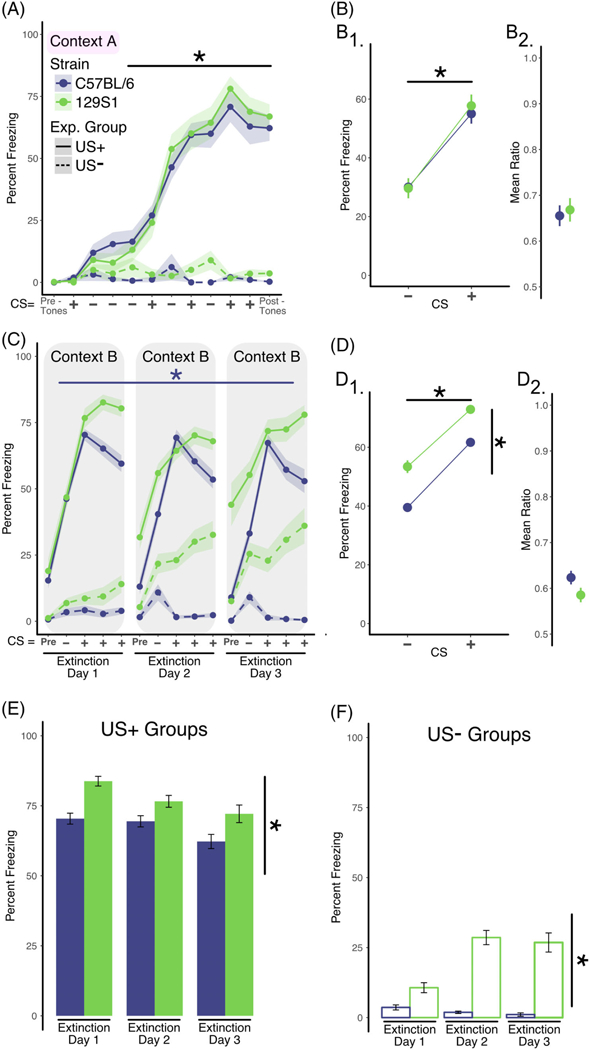FIGURE 1.

Comparisons between 129S1 and C57BL/6 on discriminative fear conditioning and extinction learning. A, Analysis of training data. Two separate groups of mice were used in this experiment. Mice in the US+ group (solid lines, C57BL/6; n = 20 [11 males; 9 females], 129S1; n = 17 [8 males; 9 females]) were exposed to auditory stimuli that consisted of white noise (CS−; white noise, 25 seconds) or 4-kHz pure tone (25 seconds) that co-terminated with a foot shock (CS+). Mice in the US-group (dashed lines, C57BL/6 n = 8,129S1 n = 8) received the identical auditory stimuli but did not receive the foot shocks. Mice in the US+ group exhibited increased freezing across the training session (repeated measures ANOVA; effect of training, P < .001) independent of strain. In the absence of shock, mice in the US-group did not exhibit significant levels of freezing. B, Analysis of discrimination learning during training. The mean percent freezing averaged across all CS+ presentations during training was significantly greater in both strains when compared with the mean freezing in response to the CS− presentations (B1, two-factor ANOVA; effect of CS, P < .001), and there was no difference in the discrimination ratios for the two strains (B2). C, Analysis of within-session extinction learning. Twenty-four hours following training, mice in both groups were exposed to four CS− stimuli followed by 12 CS+ presentations (displayed in bins of four stimuli) in a new context (context B) for 3 days (extinction days 1–3). Repeated exposure of the C57BL/6 mice to the CS+ tone in the US+ group resulted in significantly less freezing within extinction sessions shown by repeated measures ANOVA, where data are collapsed across days of training (effect of bin, P < .001). Conversely, repeated exposure to the CS+ tone in the absence of shock in the 129S1 mice failed to reduce freezing within the extinction sessions. D, Analysis of tone discrimination during extinction. Mice in both strains exhibited significantly more freezing when exposed to the CS+ tone (two-factor ANOVA; effect of CS, P < .001) and significant differences in freezing by strain (effect of strain, P < .0001) (D1). Similarly, there was no significant difference between the C57BL/6 and 129S1 strains when the discrimination ratio was calculated (D2). E, Analysis of extinction across days (US+ Group). Freezing across extinction days was analyzed by calculating the mean percent freezing for the three binned CS+ presentations for each of the three extinction days (solid line in panel C). While both C57BL/6 and 129S1 mice exhibited modest reductions in freezing across extinction days, this effect was not significant, although 129S1 mice freeze more as compared to the C57BL/6 (two-factor ANOVA; effect of strain, P < .001). F, Analysis of freezing in the US-group across days. Freezing in the US-group was calculated each day as the mean percent freezing measured during the CS+ tone presentations (dashed line in panel C). Somewhat surprisingly, the 129S1 mice exhibited increased “freezing” across the 3 days of re-exposure to the CS+ tone compared with the C57BL/6 strain (two-factor ANOVA; effect of strain, P < .0001), in spite of the fact that they never received the foot shock. Data shown as sample mean with shaded region or bars representing the SE of the mean. Asterisk (*) denotes statistical significance for main effect of training (horizontal line) or strain (vertical line). Data are presented as mean ± SEM
